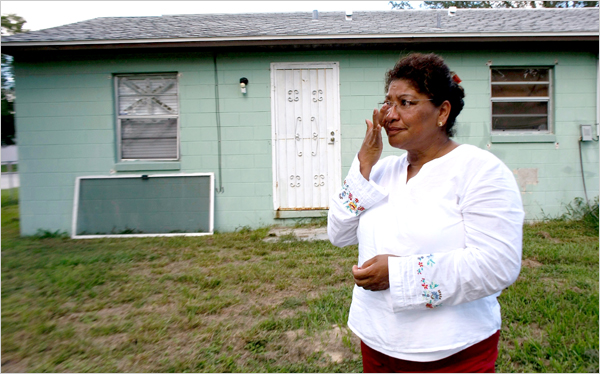| Want to send this page or a link to a friend? Click on mail at the top of this window. |
| More Books and Arts |
| Posted November 4, 2007 |
What's Behind the Race Gap? |
|
 |
|
Joe Raedle/Agence France-Presse - Getty Images |
|
| EX-HOMEOWNER Estella Alchino of Orlando, Fla., was late paying her mortgage and lost her house. |
By VIKAS BAJAJ |
and FORD FESSENDEN |
High-cost subprime mortgages have often been framed as loans that catered to people with blemished credit records or little experience with debt.
There has been less attention paid to the concentration of these loans in neighborhoods that are largely black, Hispanic, or both. This pattern, documented in federal loan records, holds true even when comparing white middle-income or upper-income neighborhoods with similar minority ones.
Consider two neighborhoods in the Detroit area. One, located in the working-class suburb of Plymouth, is 97 percent white with a median income of $51,000 in 2000. To the east, a census tract in Detroit just inside Eight Mile Road has a very similar median income, $49,000, but the population there is 97 percent black.
Last year, about 70 percent of the loans made in the Detroit neighborhood carried a high interest rate — defined as 3 percentage points more than the yield on a comparable Treasury note — while in Plymouth just 17 percent did.
Last year, blacks were 2.3 times more likely, and Hispanics twice as likely, to get high-cost loans as whites after adjusting for loan amounts and the income of the borrowers, according to an analysis of loans reported under the federal Home Mortgage Disclosure Act. (Asians are somewhat less likely than whites to take out high-cost loans.)
Researchers and industry officials agree that there is probably no single explanation for the lending patterns, though the history of banks’ avoiding minority neighborhoods, the practice known as “redlining,” is a good place to start. (Experts have to resort to guesswork because the government does not require lenders to report information about borrowers’ credit scores, down payments and other details used in pricing loans.)
Lenders say that in general higher rates are justified to account for the bigger risks posed by borrowers who have a poor record at paying bills on time and defaulting on debts. And a recent Federal Reserve study noted that neighborhoods where people tend to have lower credit scores also tend to a greater concentration of high-cost loans.
The study suggests that the concentration of high-cost loans is not caused by an area’s racial makeup, though there is a correlation, said Jay Brinkmann, vice president for research and economics at the Mortgage Bankers Association.
But the Fed study also suggests that a big part of the reason may have to do with the lenders that minority borrowers do business with. The biggest home lenders in minority neighborhoods are mortgage companies that provide only subprime loans, not full-service banks that do a range of lending.
It may be that these borrowers do not have access to traditional banks, because there are no branches near them. The Community Reinvestment Act, enacted 30 years ago, was intended to address redlining by forcing banks to make loans in lower-income areas. But the law’s provisions do not apply to banks in neighborhoods where they have no branches.
“You could go into a middle-class area in Queens County that is white and there will be lots of banks on the shopping street,” said Alfred A. DelliBovi, president of the Federal Home Loan Bank of New York and a deputy secretary of the Department of Housing and Urban Development in the first Bush administration. “If you go to an area that is equal income and that is black, you won’t see many.”
Banks typically locate branches where they believe they will get the most deposits. A lower savings rate and a distrust of banks stemming from a legacy of redlining may help explain why there are fewer branches in minority neighborhoods, Mr. DelliBovi said.
A bigger reason may be that in recent years many subprime loans were not sought out by borrowers but actively sold to them by brokers and telemarketers, said Calvin Bradford, a housing researcher and consultant. A majority of the loans were refinance transactions allowing homeowners to take cash out of their appreciating property or pay off credit card and other debt.
Lenders made the risky loans, then often sold them to Wall Street investors. Many borrowers appear to have been swayed by brokers and lenders offering to look out for their best interests even when they had no obligation to do so.
“If we turn the clock back 30 years ago, we had redlining,” said Nicholas Retsinas, director of the Joint Center for Housing Studies at Harvard University. “In the last few years, we have had the opposite — an overextension of credit by lenders and an overextension by borrowers.”
The country needs to find a balance, “a way to extend credit at a reasonable cost to people with impaired credit,” he said. The government, through programs like the Federal Housing Administration and the big mortgage purchasers Fannie Mae and Freddie Mac, must play a critical role, Mr. Retsinas said, adding that he worries that the efforts initiated so far are not robust enough.
“There are lots of people trying to do the right thing,” he said. “But at this time I’m not very sanguine that we will deal with this in a concerted manner.”
Copyright 2007 The New York Times Company. Reprinted from The New York Times, Week in Review, of Sunday, November 4, 2007.
| Wehaitians.com, the scholarly journal of democracy and human rights |
| More from wehaitians.com |